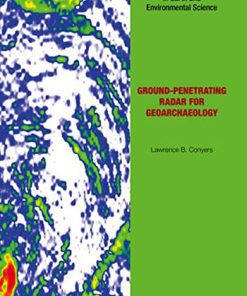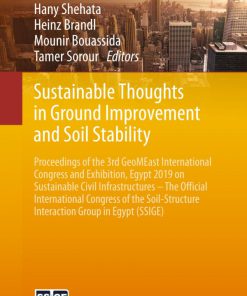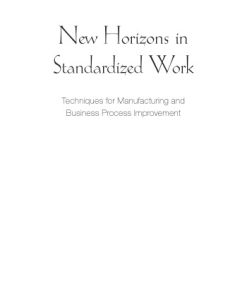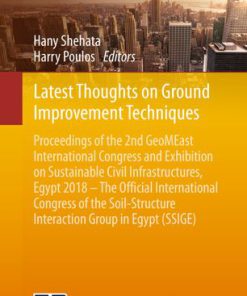Ground Improvement Techniques 1st Edition by Bujang Huat,Vivi Anggraini,Sina Kazemian,Arun Prasad 0429017960 9780429017964
$50.00 Original price was: $50.00.$25.00Current price is: $25.00.
Ground Improvement Techniques 1st Edition by Bujang Huat,Vivi Anggraini,Sina Kazemian,Arun Prasad – Ebook PDF Instant Download/Delivery:9780429017964,0429017960
Full download Ground Improvement Techniques 1st Edition after payment
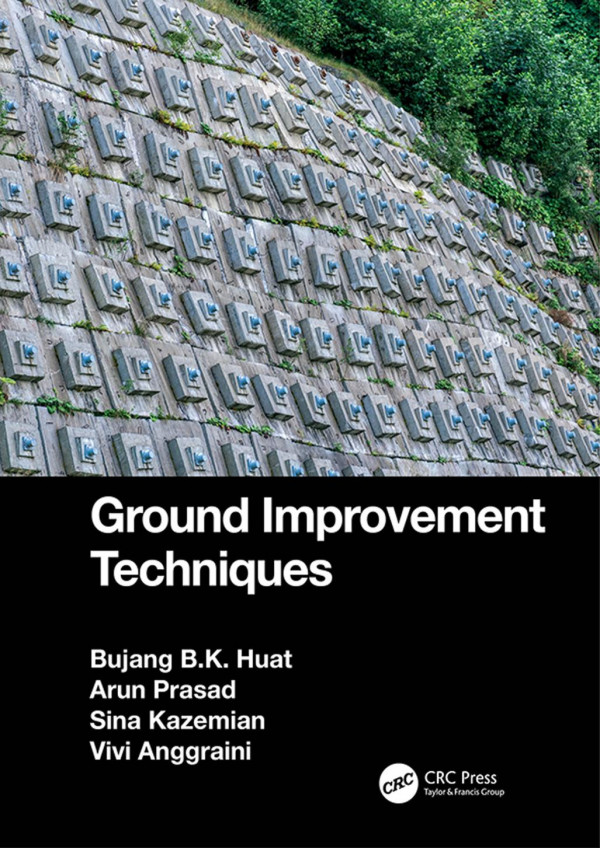
Product details:
ISBN 10:0429017960
ISBN 13:9780429017964
Author:Bujang Huat,Vivi Anggraini,Sina Kazemian,Arun Prasad
This book provides a review of problems during design and construction on problematic soils. Design methods, site investigation, construction and analysis of the various improvement methods available are explained and discussed. Various regions may have different soils with geotechnical problems that differ from those faced in other regions. For example, in Southeast Asia, the common geotechnical problems are those associated with construction on soft clays and organic soils, while in the arid region of the Middle East, problems are generally associated with the desert soils. In the US, the problems are associated with organic soils, expansive and collapsing soils, and shale. Laterite and lateritic soils are especially problematic in Mexico. Similarly, in Europe, for example, the geotechnical problems are associated with loess (France), and organic soil (Germany). A detailed description of various methods of ground improvement has been provided in 11 chapters. Each chapter deals not only with a description of the method but also focuses on region-specific ground problems and suitable ground improvement techniques. Case studies have also been included. One general chapter is dedicated to site investigation, instrumentation, assessment and control. This book will be of value to students and professionals in the fields of civil and geotechnical engineering, as well as to soil scientists and engineering geologists.
Ground Improvement Techniques 1st Table of contents:
1 Introduction
1.1 Introduction
1.2 Ground improvement techniques – a brief introduction
2 Earthworks and field compaction
2.1 Introduction
2.2 General principles of compaction
2.3 Laboratory compaction test
2.4 Field compaction
2.4.1 Smooth wheel roller
2.4.2 Pneumatic tired roller
2.4.3 Sheep foot roller
2.4.4 Grid roller
2.4.5 Vibrating roller
2.5 Field specification and control
2.5.1 Sand replacement method
2.5.2 Core cutter
2.5.3 Rubber balloon method
2.5.4 Nuclear density method
References
3 Vibro-and dynamic compaction
3.1 Introdflotation uction
3.2 Vibro-flotation
3.2.1 Design principle
3.2.2 Construction method
3.2.3 Correction for column compressibility
3.2.4 Correction for overburden
3.3 Miscellaneous techniques
3.3.1 Geopiers
3.3.2 Mortar sand rammed column (MSRC)
3.4 Dynamic compaction
3.4.1 Design
3.4.2 Construction method
References
4 Replacement method, stage construction, preloading and drainage
4.1 Replacement method (excavation and backfilling)
4.1.1 Design
4.1.2 Construction technique
4.2 Stage construction
4.2.1 Design and construction
4.3 Preloading
4.3.1 Surcharge
4.3.2 Design and construction
4.3.3 Vacuum preloading
4.3.4 Design method
4.3.5 Construction technique
4.4 Drainage methods
4.4.1 Consolidation process
4.4.2 Vertical drainage method
4.4.3 Design of vertical drainage system
4.4.4 Technique for installation of vertical drains
4.4.5 Horizontal drains
4.4.6 Horizontal drain installation method
4.4.7 Electro-osmosis
4.4.8 Electro-osmosis treatment installation method
References
5 Fibers and geosynthetics
5.1 Introduction
5.2 Fiber-reinforced soil
5.3 Geosynthetics
5.3.1 Geotextiles
5.3.2 Geogrids/netting
5.3.3 Geocomposite
5.3.4 Geocells
5.4 Geosynthetics usage in civil engineering
5.4.1 Separation
5.4.2 Reinforcement
5.4.3 Drainage
5.4.4 Erosion control
5.4.5 Liners
5.5 Use of synthetic reinforcing fabric for construction of embankments on soft ground
5.6 Factors influencing design of embankment reinforced with fabrics
5.7 Design method
5.7.1 Bearing capacity failure
5.7.2 Internal stability
5.7.3 Foundation stability
5.7.4 Overall stability
5.7.5 Design forces
References
6 Shallow stabilisation
6.1 Introduction
6.2 General principles of additive stabilisations
6.3 Types of additives used in soil stabilisation
6.3.1 Lime stabilisation
6.3.2 Cement stabilisation
6.3.3 Fly ash
6.3.4 Polyurethane (PU)
6.4 Modified cementitious stabilising agent
References
7 Deep stabilisation using chemical additives
7.1 Introduction
7.2 Deep mixing method (DMM)
7.2.1 Shallow soil mixing (SSM)
7.2.2 Cement deep mixing (CDM) system
7.3 Lime columns
7.3.1 The chemistry of lime treatment
7.3.2 Design and calculation methods of bearing capacity of lime, lime-cement and cement columns
7.3.3 Settlement prediction of lime, lime-cement and cement columns by Chai and Pongsivasathit (2010)
7.3.4 Bearing capacity prediction of lime, lime-cement and cement columns
References
8 Lightweight fills
8.1 Expanded polystyrene (EPS)
8.2 Ultra-lightweight (bamboo culm-RPB) foundation
8.2.1 Design example
8.3 Other lightweight materials
References
9 Grouting
9.1 Introduction
9.1.1 Hydro fracture grouting
9.1.2 Compaction grouting
9.1.3 Permeation grouting
9.1.4 Compensation grouting
9.1.5 Jet grouting
9.2 Chemical and cementation grouts
9.2.1 Sodium silicate system
9.2.2 Silicate chloride amide system and silicate aluminate amide system
9.2.3 Aminoplasts
9.2.4 Acrylamide
9.2.5 Epoxy resins
9.2.6 N–methylolacrylamide (NMA)
9.2.7 Polyurethane
9.2.8 Phenoplasts
9.2.9 Lignosulfonates
9.3 Decision on choosing the grout
References
10 Other techniques
10.1 Ground freezing method
10.2 Soil nail and micropiles
10.3 Thermal precompression
10.4 Alkaline-activated binders
10.5 Carbonation
10.6 Biogrouting
References
11 Site investigation, instrumentation, assessment and control
11.1 Introduction
11.2 Site investigation
11.2.1 Stages of site investigation
11.2.2 Sampling techniques
11.2.3 Sampling equipment
11.2.4 Site investigation report
11.3 Investigation report and test methods
11.3.1 Initial evaluation report
11.3.2 Preliminary site investigation report
11.3.3 Detailed site investigation
11.3.4 Test methods
11.3.5 Laboratory tests
11.3.6 Cone penetration test (CPT and CPTu)
11.3.7 Vane shear
11.3.8 Pressure meter
11.3.9 Plate loading test
11.3.10 In situ permeability test
11.3.11 Full-scale loading test
11.3.12 JKR probe
11.3.13 Geophysical method
11.4 Field instrumentation
11.4.1 Pore pressures
11.4.2 Observation well
11.4.3 Open standpipe piezometer
11.4.4 Double tube hydraulic piezometer
11.4.5 Pneumatic piezometer
11.4.6 Vibrating wire strain gauge piezometer
11.4.7 Bonded electrical resistance piezometer
11.4.8 Hydrostatic lag time
11.4.9 Earth pressure
11.4.10 Measurements of deformation
11.4.11 Surveying method
11.4.12 Portable deformation gauge
11.4.13 Settlement markers
11.4.14 Standpipe settlement gauge
11.4.15 Heave gauge
11.4.16 Liquid level system
11.4.17 Inclinometer
11.4.18 Soil strain gauge
11.4.19 Fiber-optic sensors
11.5 Choice of instruments
11.6 Assessment and control
People also search for Ground Improvement Techniques 1st :
sand drains in ground improvement techniques
ground improvement techniques in geotechnical engineering
ground improvement techniques ktu notes
ground improvement techniques anna university question paper
ground improvement techniques are especially valuable in areas with
Tags:
Bujang Huat,Vivi Anggraini,Sina Kazemian,Arun Prasad,Improvement
You may also like…
Business & Economics - Management & Leadership
Politics & Philosophy
Ground penetrating radar for geoarchaeology 1st Edition by Lawrence Conyers 1118950029 9781118950029
Engineering - Civil & Structural Engineering
Business & Economics
Earth Sciences
Geology of the Himalayan Belt. Deformation, Metamorphism, Stratigraphy 1st Edition B.K. Chakrabarti
Engineering - Civil & Structural Engineering






